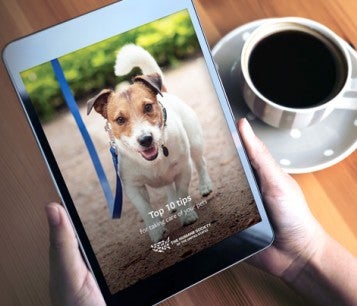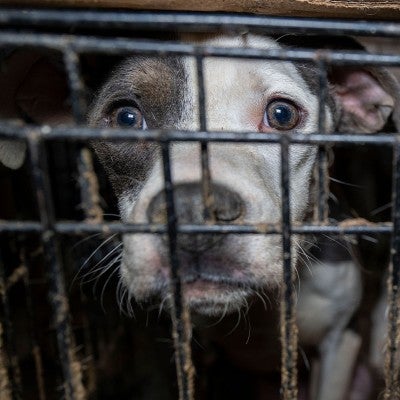Dogs peeing in unwanted spots, whether it’s in the house or on top of a flower garden in the backyard, can be stressful for pet owners. But with some work and patience, you can address the problem and help prevent future incidents.
If you have already successfully completed potty training, your dog may be peeing in unwanted spots to mark their territory, or it could be submissive urination, in which a dog pees as a response to fear or anxiety.
Before doing anything else, take your dog to the veterinarian to rule out any medical causes for the behavior. If they get a clean bill of health, use the following tips to stop your dog from peeing in the house or in a certain spot outside.
Is it urine-marking or submissive urination?
Submissive urination can be more common in young puppies who are gaining confidence but can also occur in adult dogs. If your dog pees after experiencing the following triggers, you are probably dealing with submissive urination:
- Loud or angry voices
- A person approaching/greeting them
- A disturbance such as sirens blaring
- Or while also making submissive postures, such as crouching, tail tucking or rolling over and exposing their belly
If your dog urinates when they are playing or being greeted, but doesn’t exhibit submissive postures, it could be excitement urination. If your dog does not display any of these symptoms, they may be urinating to mark their territory. A veterinarian can also help you get to the route case of the behavior.
How to address submissive urination
Dogs who behave this way are usually shy or anxious, and may have a history of being punished for having accidents or jumping up on people. If a dog lives in a home where the guidelines constantly change or one person expects different things than another, this can exacerbate any existing stress.
If your puppy or dog has exhibited this behavior consistently, building their confidence through positive reinforcement-based methods will make a world of difference.
- Keep their routine and environment as consistent as possible and advocate for them in situations that might spark the behavior. For example, if your dog urinates when strangers bend over and greet them, politely ask strangers to keep their distance and toss a treat to your pup instead.
- With people your dog is more comfortable with, teach friends or family to approach appropriately. They should avoid direct eye contact, approach from the side rather than head on and get down on their level by bending at the knees rather than leaning over from the waist. If the dog approaches without rolling over, the person can slowly pet them under the chin rather than the top of their head. Keeping voices low will also help your pup feel safe.
- Gradually expose them to new people and new situations and work to ensure that their new experiences are positive and happy by always carrying high-value treats with you. If you’re on a walk and getting closer to a stranger, ask your dog to sit if they know how or simply reward them with treats as the stranger passes.
- Give your pup something else to do like sitting, lying down or doing a trick. When dogs use their brains, they’re less likely to get stuck in a cycle of fear. Of course, if your dog is too scared, don’t ever force them to do a behavior. Instead, increase your distance from the thing or person that is scaring your pup.
- Eliminate odors wherever your dog submissively urinates, especially if they aren't completely house-trained.
- Don't punish or scold them for submissive urination. This will only make the problem worse.
- If your dog is extremely fearful, ask your vet about medications that may help during the retraining process.
Above all, be patient. It will take time for your dog to gain confidence, but with time, they can overcome their fears and blossom into a happier, more confident dog.
Sign up to receive our exclusive e-book full of important information about caring for your pet, including training techniques and answers to frequently asked questions.

How to address urine-marking
Spay or neuter your dog as soon as possible. The longer a dog goes before being spayed or neutered, the more difficult it will be to train them not to mark in the house. Spaying or neutering your dog should reduce urine-marking and may stop it altogether.
But if they have been marking for a long time, a pattern may already be established. Because it has become a learned behavior, spaying or neutering alone won't solve the problem. Use techniques for housetraining an adult dog to modify your dog's marking behavior. Don't punish your pet. Punishment only increases their anxiety and may cause them to hide when they need to go to the bathroom, thereby decreasing their ability to give you a cue when they need to go outside.
- Clean soiled areas thoroughly with a cleaner specifically designed to eliminate urine odor.
- Make previously soiled areas inaccessible or unattractive. If this isn't possible, try to change the significance of those areas to your pet. Feed, treat and play with your pet in the areas where they mark.
- Keep objects likely to cause marking out of reach. Items such as guests' belongings and new purchases should be placed in a closet or cabinet.
- Resolve conflicts between animals in your home. If you've added a cat or dog to your family, follow our tip sheets to help them live in harmony.
- Make friends. If your pet is marking in response to a new resident in your home (such as a roommate or spouse), have the new resident make friends with your pet by feeding and playing with your pet. If you have a new baby, make sure good things happen to your pet when the baby is around.
- Watch your dog when they are indoors for signs that they are thinking about urinating and calmly take them outside. When you’re unable to watch them, put your dog in a crate (if they’re crate trained) or consider tethering your dog to you with a leash when you’re distracted (like when cooking dinner) to monitor them for signs they need to urinate.
- If your dog is marking out of anxiety, talk to your vet about whether medications may be appropriate.
- Consult an animal behaviorist for help with resolving the marking issues.
What not to do
Don't punish your pet. Punishment only increases their anxiety and may cause them to hide when they need to go to the bathroom, thereby decreasing their ability to give you a cue when they need to go outside.
While it can be frustrating to come home to an accident, simply clean it up and consider what might have caused it. Do you need a dog walker midday or does your dog enjoy their crate and can this help reduce the accidents they’re having while keeping your home cleaner?

